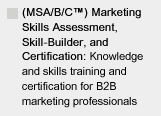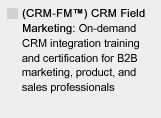MAKE SURE YOU CONTINUE TO RECEIVE EACH ISSUE OF TUESDAY MARKETING NOTES—CLICK HERE TO RENEW YOUR FREE SUBSCRIPTION
Marketing for the Lean Start-Up:
Breaking the "Reality Distortion Field" With Market Testing and Brutal Honesty
by Eric Gagnon
When you’re a marketing professional, there’s no more exciting role than to be involved in a new venture start-up or a new product launch. If you’re the kind of person who likes an environment where everything that’s being done is being done for the first time, and where there’s never anyone around to say “we’ve always done it this way,” then you belong in a start-up or new product launch.
Since new product launches for an existing company also often involve introductions into new markets, for the most part many of these observations I’m making here for start-ups also apply to new product launches in more established companies.
You Are Accountable to Sales
An organization chart for a product launch team or a start up may have your name drawn in it, with the title “VP, Marketing,” or “VP, Product Management,” but the reality is that during the initial launch you are responsible for generating sales, by generating sales leads, in your start-up or product launch.
Your first-mover effort in your marketing program, and the behind-the-scenes testing and business development activities you execute in the early days of your launch or new venture to see if you have a business, will be responsible for bringing these first new customers and sales revenue into your start-up or new product launch.
Sure, on the org chart there might be a sales guy in the “VP, Sales” box next to you, but when the sales curve is starting from zero, he’ll be looking to your marketing program to generate the early prospect leads he’ll be working on.
What this means is that marketing managers in start-ups and new product launches need to think more like sales reps and less like high-level strategists during the planning and early implementation stages. There will be plenty of bright guys scribbling their ideas on white boards, but you’re the one who has to make the phone ring in the real world.
In Start-Up, Beware of the Founder’s “Reality Distortion Field”
Founders in a start-up are often charismatic figures, who hold rock-solid positive belief in themselves, and their start-ups. This is a necessary trait for entrepreneurs, and it gets them through all of the obstacles and adversity they face in building their company, getting it funded, and launched.
But many founders develop a “reality distortion field” around them, which sometimes leads to a denial that blinds them to the true market reality of their start-up. For example, a founder may be so attached to his own ideas for selling his product in the same way it’s been sold for months, even after everyone around him can see that the current marketing and sales program isn’t working.
This is the point where the founder’s committment goes beyond reason into the stubborn denial of reality, and it happens more often than you’d think. Initially, your startup’s engineers or product managers will be less impacted by the marketing realities of a failed advertising program or lukewarm market acceptance, but you’re not, since you’re the one closest to the marketing program.
As a marketing manager, outside agency, or consultant receiving the bad news about your marketing program you can’t afford to fall back into the warm security blanket of the startup’s group delusion, fed by the founder’s denial. Your job is to report the bad news immediately like a cold slap in the face (and to keep slapping if people don’t hear it the first time), offer workable alternatives, and get a new and improved marketing program back into action as quickly as possible, based on the lessons learned.
The faster you can identify what’s wrong with your marketing program, make changes to it, and start executing these new marketing programs, the closer you will be to turning this flat or underperforming marketing program around.
Let Everyone Else Follow the Business Plan, Your Job is To See if There’s a Business
Let me tell you a dirty secret of every start-up or a product launch: Ultimately, it’s not about the idea, the technology, or even the quality and character of the people involved in the startup (although the latter is certainly very important). The fundamental question that needs to be asked and addressed is: “Do we have a business?”
Sure, your business plan has been written, you’ve segmented your markets and identified your likely prospects, but the most important next step is determining whether or not your marketing plan can generate the real-world sales response necessary to profitably sell your product. For example:
• When you run a print ad, how many inquiries will it generate?
• What percentage conversion will your direct mail program reach?
• What’s the click-through conversion rate on your online marketing program?
All of these questions are a measure of your marketing program’s sales response, and the final result always boils down to determining whether or not you have a business.
Since you—and your marketing plan—are responsible for sales in the start-up or product launch, it’s your job to answer this question, and the best way to do this is to test.
To See If You Have a Business, TEST!
Market testing isn’t just for big corporations who can afford to hire fancy research firms. Any start-up or new product launch can run a few simple market tests, using direct mail and the telephone, to test the effectiveness of marketing deliverables, advertising media, and the value, price, features, and benefits of their product, to answer the question: “Do we have a business?”
Market testing for a start-up or product launch is no big deal. What I’m talking about here basically amounts to printing mockups of your ads, brochures, and sales materials for your product, sometimes even before your product is even ready to sell, and getting these materials in front of a dozen, or two dozen, likely prospects for your company’s product or service, and then asking these prospects for their feedback and advice on these materials, and your product. Then, after the copy and presentation of your marketing deliverables is dialed in, run a smaller version of your marketing program to gauge your product’s sales response.
Market tests for start-ups and product launches run in two stages:
1. The Initial Market Test
The initial market test is a a very basic test done 1-3 months before the product is publicly launched. The purpose of this test is to gauge the response to copy and presentation of your marketing deliverables and, to a lesser extent, gather information on the kinds of “marketing media” you should be using in your marketing program, such as mailings, ads, trade shows, Internet, etc.
In this initial test, you put samples of ads, brochures, Web pages etc. in front of representative prospects and other contacts in your market, and informally interview them for feedback on how well your sales copy presents and sells your new product, and how they get information on other products in your industry—i.e., what kinds of trade publications they read, what kind of mailings they get from other companies in their field, what trade shows they attend, Web sites they access, etc.
This initial market test is often done while your company or start-up is operating “under the radar,” and by contacting these potential prospects and other trusted industry contacts before your product is even ready to sell.

2. The “Live” Market Test
The “live” market test, which is usually run before your launch date, or as a scaled-down version of your marketing program during the product launch phase, is mainly a test to gauge the sales response of the marketing media you’re using in your program: Print advertising, direct mail, Internet search engines, e-mail, trade shows, etc.
The “live” market test may include all of the activities of your marketing program, but on a smaller scale: For example, you may be running a reduced, two-month schedule of print ads, sending out a half-dozen or so mailing tests to selected lists, and testing the effectiveness of your Internet marketing program.
Once you have worked out the basic sales copy and presentation of your deliverables in the initial market test, and you’ve generally defined the methods and media you intend to use to market your company’s product, the purpose of the “live” market test is to help you establish sales response: response rates from mailings, number of inquiries received from ad placements, click-throughs from search engine tests, etc.
The “live” market test seeks to answer the ultimate question for any start-up, and for many new product launches in established companies: “Do we have a business?”
The Value of Market Testing
I’ve run market tests that have gone on to generate millions of dollars in sales volume for new ventures, and I’ve run tests that have convinced clients to close up shop and walk away, saving them millions in money they (or their investors) would have thrown at a bad venture. You learn something useful from every test, and everything you learn can be put back into your marketing program to make it more effective in its next implementation.
Often, however, the results of any test won’t be clear cut, and will require another test. And usually another one after that. That’s where your commitment, staying power, and your ability to rapidly execute another market test means the difference between giving up on a venture, or finding the key to breaking through the market and generating enough sales response to make the business profitable. With each new test, you’ll learn at least one important piece of information that will help you sell your product better.
Every Marketing Plan is a Diversified Portfolio
Savvy investors spread their investment risk by diversification: That is, making investments across a wide variety of opportunities, so that a failure in one investment can be offset by the succes of other investments in their portfolio.
The key to market testing in a start-up or product launch is to execute as many plausible marketing activities as possible, knowing that some of these activities may generate little or no sales response, some will produce only so-so response, but a few of these marketing projects may generate very profitable sales response.
During testing, the key is to get the marginal activities weeded out early in your marketing program before they become money-wasting elements of your marketing program, to revise and improve the activities generating marginal results, and to ramp up the successful parts of your program to generate solid early sales response for your company.
Market Test Activities
When setting up market tests for a start-up or new product launch, execute a small-scale version of every marketing activity available to a company operating in a B2B market, including the activities below, in their order of importance:
1.) Trade Shows: An early trade show appearance, if possible;
2.) Direct Mail: Mailings to targeted, self-compiled, and/or rented lists;
3.) Print Advertising: Limited print advertising placements;
4.) Early Big Deals: OEM, private label, “in the box,” or co-marketing deals with a large corporation or another company;
5.) Internet: AdWords tests, search engine optimization trials, opt-in email;
By the way, never underestimate the value of an “early big deal:” Doing a major co-marketing deal with a large company, as in 4.) above, can give your start-up or product launch a huge initial boost. Combining your product with a much larger company’s sales and marketing machine helps both of your companies, and gives your new product the exposure it would never receive in its own marketing program.
Examples of these kinds of “in the box” deals include co-marketing deals where a larger corporation can offer your product to its customers and prospects, if your product is a useful addition to the larger company’s product line.
In a B2B environment, there are many opportunities to combine your company’s complementary product with another: Software with hardware, information products with manufactured products, manufactured products with services. Related examples include OEM and private-label deals, where other, larger companies market and sell your product under their brand name. Give some thought to your company’s product and I’m sure you can find similar ways to connect it with another, larger company’s products through a co-marketing deal.
Effective Market Testing Requires Effective Marketing Execution
If you have a good product, at a good price, and if prospects want the product, then the rest is clear, effective presentation and good marketing execution. But you’ll never know any of this if you don’t test, and if you don’t test enough ways to sell your product in a start-up or product launch, you may never get your company’s product in front of enough marketing opportunities to discover which of these will generate the most profitable sales response.
Testing, like every other marketing activity, begins and ends with timely, competent, effective marketing execution. If you can execute well, you can test many different ways to market and sell your company’s product. Even if most of those opportunities don’t work out, or if they yield marginal results, with good execution you can improve the marketing projects that can be fixed, get those back into action, quickly scale up the ones that do work, and start making the phones ring. Your ability as a marketing professional to execute, and keep executing, often means the difference between success or failure in a start-up or new product launch.
Eric Gagnon (eric@businessmarketinginstitute.com), a director with the Business Marketing Institute, is author of The Marketing Manager’s Handbook and The CRM Field Marketing Handbook.








